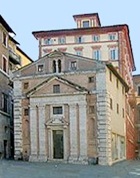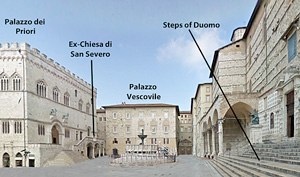
This walk begins in what is now Piazza IV Novembre, in front of the left wall of the Duomo.
A deep declivity here, between the Colle del Sole to the north (ie to the right in this photograph) and Colle Landone to the south, was filled in at an unknown time to create the terrace that supported the Etrusco-Roman forum. Its supporting walls along Via Maestà delle Volte and Via delle Cantine (below) were broadly contemporary with the Etruscan city walls, while the stretch under Palazzo dei Priori seems to date to the Roman period.
This forum marked the intersection of the principal roads of the ancient city:
-
✴the cardus maximus, which ran from Arco di Augusto in the north to Porta Marzia in the south; and
-
✴the decumanus maximus, which ran from Porta Trasimena in the west to Arco dei Gigli in the east.
Excavations have uncovered two large Roman cisterns under the paving of what is now Piazza IV Novembre, one in front of Palazzo Vescovo and another at right angles to it, in front of the ex-church of San Severo (now part of Palazzo dei Priori).
A fortified structure known as the Castello di San Lorenzo which incorporated the old Duomo (San Lorenzo), had been established on this terrace by the 10th century. This complex housed the ecclesiastical authorities of the city and, from at least the 11th century, the residence of the canons of San Lorenzo. The secular administration of the city began to establish itself here in 1205, after which the area became the civic as well as the spiritual heart of the city.
The medieval Piazza Grande, which was laid out in the 13th century, originally comprised what are now:
-
✴Piazza IV Novembre (created by reducing the height of the Roman terrace to the left of the Duomo by some 2 meters);
-
✴Corso Vannucci, as far south as (and including) Piazza della Repubblica; and
-
✴Piazza Danti, to the west.
Piazza IV Novembre
The piazza is named for the date of the plebiscite of 4th November 1860, in which the people of Umbria voted by 97,040 to 380 to join the new Kingdom of Italy under King Vittore Emanuele II.
Its focal point is the Fontana Maggiore, which the Commune commissioned to underline and celebrate the political dominance of Perugia in 1277-8.
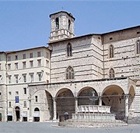
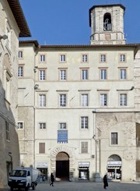
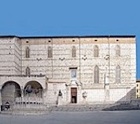
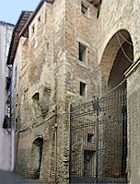
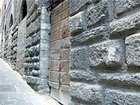
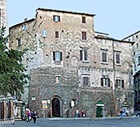
-
✴A large part of the wall that supported the terrace of the Etruscan acropolis has been excavated below and parallel to the curtain wall of the palace.
-
✴A Roman road that ran along this retaining wall probably connected with the similar one that has been excavated under Piazza Cavallotti (in the area that can be entered down the steps in the pavement here).
-
✴A number of antefixes (2nd and 1st century BC) that were found here seem to have come from what must have been the most important temple in Perusia; it may have been the temple dedicated to Uni (Juno) that miraculously escaped destruction after the Perusine War (40 BC).
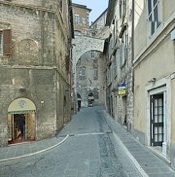
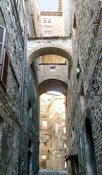
Continue along Via Maestà delle Volte, with the imposing palace walls still on your left. [This takes you through the extraordinary vestiges of the Castello di San Lorenzo].
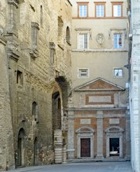
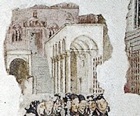
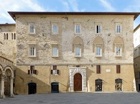
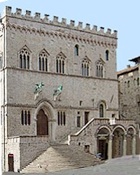
Corso Vannucci to Piazza della Repubblica
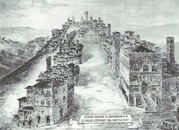
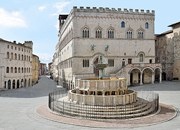
Turn right into Corso Vannucci, which is named for Pietro Vannucci, il Perugino, the most important local artist in the Renaissance. This print (1947) by Giovanni Ellero reconstructs how the southern part of Piazza Grande originally extended in this direction, towards the tower houses of Colle Landone.
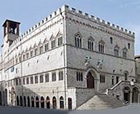
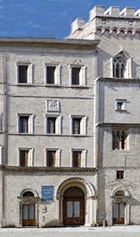
-
✴Palazzo Lippi-Alessandri at number 39-43; and
-
✴Palazzo Graziani at number 47-53.
You are now at what was the narrowest and lowest part of the Etruscan city. To get an idea of how much the street level has risen, take a detour to the right down the steps of Via della Luna to Via della Cupa, where the Etruscan walls still form the foundations of the terracing that prevents the city from sliding into the valley below.
Continue into Piazza della Repubblica, which was the probable site of the Roman forum. It was also the site of the Fontana Minore, which stood “in pede fori” (at the end of the forum).
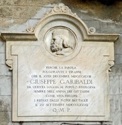
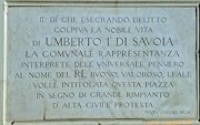
Inscription commemorating Inscription commemorating
Giuseppe Garibaldi King Umberto I
The piazza developed its own political identity in the late 18th century:
-
✴A tree of liberty was erected here during the French occupation of Perugia in 1798.
-
✴An inscription on the facade of Palazzo Baldeschi Cennini (at number 66-70 on the left) records that Giuseppe Garibaldi addressed the Perugians from the balcony here in 1848.
The piazza was re-named for King Umberto I in 1890: an inscription on the facade of Palazzo Ceccoli (at number 72-82) mourns the murder of this “good, brave and loyal” king in 1900. The piazza was renamed again in 1946 for the newly proclaimed Italian Republic.

The rest of Corso Vannucci is described in Walk VII.
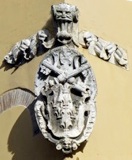
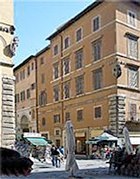

Retrace your steps along Corso Vannucci to Via Mazzini on the right. The papal legate Tiberio Crispo substantially widened this street in 1547 to improve the access to what is now Piazza Matteotti. He placed the arms of Pope Paul III on the left corner and his own arms on the right corner; the former seem to have been moved from the facade of the short-lived Farnese palace, which had been replaced by Rocca Paolina in 1542.
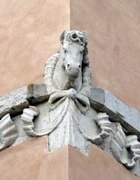

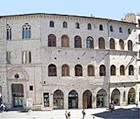
Palazzo Friggeri (1730) is across Via Calderini, at number 36 Piazza IV Novembre. Walk past it into Piazza Danti.
Piazza Danti
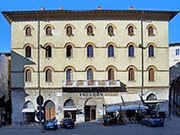
Continue into Piazza Danti, past the facade of the Duomo on the left.
-
✴Palazzo Conestabile della Staffa is opposite the facade (at number 28);
-
✴the entrance to the Pozzo Etrusco (see Walk II) is at number 18; and
-
✴Palazzo del Teatro Turreno (illustrated above) is ahead of you, at number 10-6, between Via del Sole and Via Bartolo. It used to house Teatro Turreno.
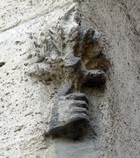
The piazza took on its current form in 1547, when a number of buildings cluttering the space were demolished as part of the urban redevelopment of Cardinal Tiberio Crispo. It became known as Palazzo del Papa in 1816, when the statue (1555) of Pope Julius III that is now in front of the Duomo was temporarily moved here. The statue was returned to its current location in 1899 to make way for the new tramway, and the piazza was renamed again at this point in honour of the family of Vincenzo Danti, the sculptor of the papal statue.
Return to Piazza IV Novembre, where the walk ends.




